An AMD Threadripper X399 Motherboard Overview: A Quick Look at Seven Products
by Ian Cutress & Joe Shields on September 15, 2017 9:00 AM ESTASUS
ASUS enters the Threadripper arena with two motherboards available at launch: the Republic of Gamers Zenith Extreme and the Prime X399-A. A third board, the ROG Strix X399-E, is set to follow.
ASUS Republic of Gamers (ROG) X399 Zenith Extreme
The first board, the ROG Zenith Extreme, is positioned at the top of the ASUS X399 product stack. As is typical with ASUS Extreme motherboards, the aim is to include considerable numbers of features to support the high-end positioning. This means overengineering, extra cooling, overclocking functionality, extra support, and using higher end controllers such as 10G networking through a bundled add-in card. This is one of ASUS’ boards that also implements their custom DIMM.2 slot, which looks like a DRAM slot but actually supports enough PCIe lanes for two additional M.2 drives placed vertically.
As with most Threadripper motherboards, the Zenith has eight DDR4 memory slots for quad-channel memory, supporting a total of 128GB of both ECC and non-ECC memory. ASUS states a supported overclocked speed up to DDR4-3200, due to ASUS’ T-Topology trace layout, although users can overclock beyond this should they wish.
For the power delivery, the Zenith uses an eight phase design. This is paired with two heatsinks connected via a heatpipe, spreading the thermal capacity from above the VRM to near the IO. The heatsink near the IO has a finned portion to increase the surface area, and also includes a 40mm fan which sits under the I/O shield. It is designed to spin up only when needed, although based on our testing sample sent by AMD for the Threadripper launch, at max RPM it gets sufficiency loud. Power to the VRM is handled by two 8-pin EPS 12V ports located on the top right corner.
While any of the AM4 boards can overclock Threadripper, ASUS positions the Zenith as having a few more features on it compared to the others. This includes LN2 and Slow Mode switches, for users wanting an increased voltage range and/or have trouble getting to the OS under sub-zero conditions, as well as Retry and Safe Boot buttons for a failed POST. There are also switches to disable the PCIe Slots individually, to minimize any potential variation when really pushing the clock speeds under extreme cooling environments. The Zenith also has an external BCLK / base frequency generator, for additional flexibility when overclocking.
The Zenith supports SLI and Crossfire, which breaks down as x16/x8/x16/x8 from top to bottom with the full-length reinforced PCIe slots. The final PCIe x8 slot is actually bifurcated again to x4/x4, such that when the U.2 port is being used, the final slot shares half of its lanes with it, giving x16/x8/x16/x4 for the slots and x4 for U.2 functionality. There is also a PCIe 2.0 x4 slot from the chipset in the middle, with the aim of this slot to be for the ROG Areion 10G card which enables 10 gigabit Ethernet functionality to the system. This allows users with two graphics cards to get the best slot positioning as well as support for 10G and U.2 all in one system.
The main PCIe slots account for 48 of the onboard CPU PCIe lanes, which leaves 12 left. ASUS has put them to M.2 storage, where one slot is found underneath the heatsink and the other two are from ASUS’ custom DIMM.2 slot. DIMM.2, for those that haven’t seen it before, looks like a DRAM slot but uses a riser card to support a pair of additional 22110 M.2 drives. Three drives at four lanes a piece brings the total CPU lanes up to 60.
For network connectivity, the ROG Zenith Extreme also does something a little different. Under the normal networking category, we have a single Intel I211-AT gigabit Ethernet controller leading to one port on the rear panel. Users can equip the bundled 10G card for an additional Ethernet port as well. Under the abnormal networking category is the WiFi: ASUS has equipped the board with a WiFi card that supports both 2x2 802.11ac with MU-MIMO as well as 802.11ad 60 GHz WiGig. We first saw WiGig in action several years ago at MWC from Wilocity, and when that company were purchased by Dell we saw WiGig came to enterprise laptops. At the time it was a near-line-of-sight technology, working at less than 10 meters. ASUS states that combined with 802.11ac, their WiGig solution can support a combined speed up to 4600Mbps. As we’ve mentioned before, ASUS also includes their ROG Areion 10G expansion card, which uses the Aquantia AQtion AQC107 controller.
Audio functionality on the Zenith is handled by ROG SupremeFX, which incorporates ASUS’ version of Realtek’s ALC1220 (the ALC1220A) but also comes with an ESS SABRE9018Q2C integrated DAC/AMP for front panel ports, enabling better audio fidelity. By contrast, most Threadripper boards will use the ALC1220 in a custom audio profile, or Creative’s Core Sound3D. The S1220A, ASUS says, is a tweaked version of the ALC1220 by removing some of the unneeded functionality for lower power operation.
For USB, on the rear panel ASUS supports one USB 3.1 (10 Gbps) Type-C port from an ASM3142, one USB 3.1 (10 Gbps) Type-A port from the same ASM3142, and eight USB 3.1 (5 Gbps) ports from the CPU. For front panel connections, ASUS has an onboard USB 3.1 (10 Gbps) header from the chipset, two USB 3.1 (5 Gbps) headers from the chipset, and a single USB 2.0 header which shares connectivity with an ROG OC Panel.
The ROG Zenith has several RGB LEDs are integrated on the board. The main focal point is on the chipset heatsink, where with the ROG symbol illuminated, but the system also has RGB LEDs on the I/O cover and a long strip running the entire right side of the board. It is worth noting that the LEDs will remain switched on even after shutting down the machine by default. Adding more LEDs is possible, with two RGB headers on the board. All of the LEDs can be controlled by AURA Lighting Control software, bundled with the motherboard.
ASUS provided a block diagram showing exactly where devices are fed from on the Zenith. At the top we see the socket supporting four M.2 drives as well as four PCIe slots. The way the routing is presented between the final slot and the U.2 port might be confusing: the final set of x4 goes around to the quick switch, and if the U.2 is present it will support the U.2, and if not it will support the final PCIe slot, giving x8 connectivity.
From the chipset we see the SATA ports, the chipset USB 3.1 (10 Gbps) header, two USB 3.1 (5 Gbps) headers and a variety of PCIe slot allocations. The first PCIe allocation is in blue, two lanes of PCIe 2.0 being used to power the ASMedia ASM3142 controller, giving two ports of USB 3.1 (10 Gbps) on the rear panel, one of which is USB Type-C. The other PCIe lanes from the chipset go to the gigabit Ethernet (Intel I211-AT), two lanes for the 802.11ac/ad, four lanes for the middle PCIe slot, and another lane for a x1 slot.
| ASUS ROG Zenith Extreme | |
| Warranty Period | 3 Years |
| Product Page | Link |
| Price | $549.99 |
| Size | E-ATX |
| CPU Interface | TR4 |
| Chipset | AMD X399 |
| Memory Slots (DDR4) | Eight DDR4 Supporting 128GB Quad Channel Up to 3600 MHz (OC) |
| Network Connectivity | 1 x Intel I211-AT GbE 1 x Aquantia 10 GbE |
| Wireless Network | 802.11ad WiGig 802.11a/b/g/n/ac 2x2 MU-MIMO |
| Onboard Audio | SupremeFX Realtek S1220 ESS SABRE9018Q2C DAC |
| PCIe Slots for Graphics (from CPU) | 4 x PCIe 3.0 x16 Supports 4-Way SLI/CF |
| PCIe Slots for Other (from Chipset) | 1 x PCIe 2.0 x4 (max) 1 x PCIe 2.0 x1 |
| Onboard SATA | 6x Supporting RAID 0/1/10 |
| Onboard SATA Express | None |
| Onboard M.2 | 3 x PCIe 3.0 x4 (2 x PCIe + 1 x PCIe and SATA) |
| Onboard U.2 | 1 x PCIe 3.0 x4 |
| USB 3.1 | 1 x Type-A 1 x Type-C |
| USB 3.0 | 8 x Back Panel 2 x Header |
| USB 2.0 | 1 x Header |
| Power Connectors | 1 x 24-pin EATX 2 x 8-pin ATX 12V |
| Fan Headers | 1 x CPU 1 x CPU Opt 2 x Chassis 1 x H_AMP 1 x W_Pump+ 1 x 5-pin EXT_Fan (Extension Fan) |
| IO Panel | 1 x Intel GbE 1 x USB 3.1 Gen 2 Type-C 1 x USB 3.1 Gen 2 Type-A 8 x USB 3.1 Gen 1 1 x Optical S/PDIF out 1 x Clear CMOS button 1 x USB BIOS Flashback Button 1 x ASUS Wi-Fi GO! module 5 x LED-illuminated audio jacks |


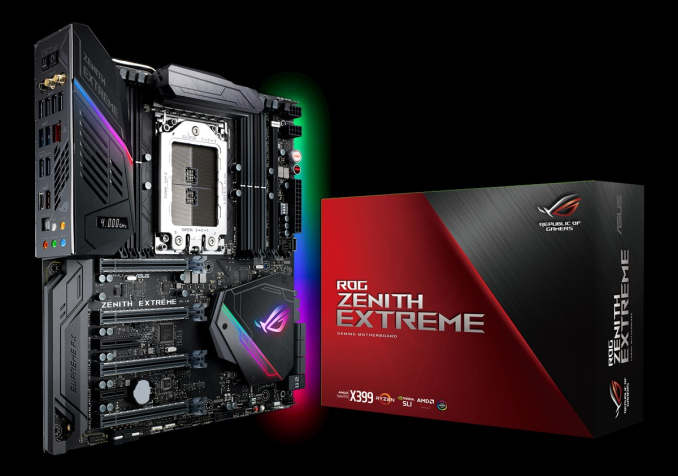
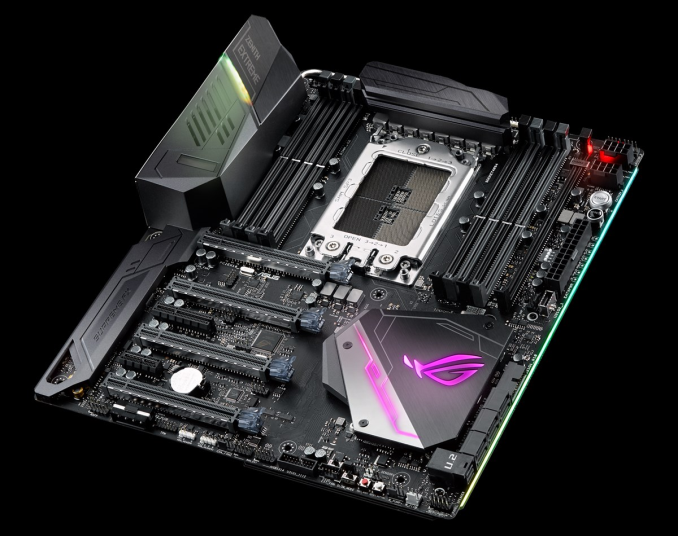
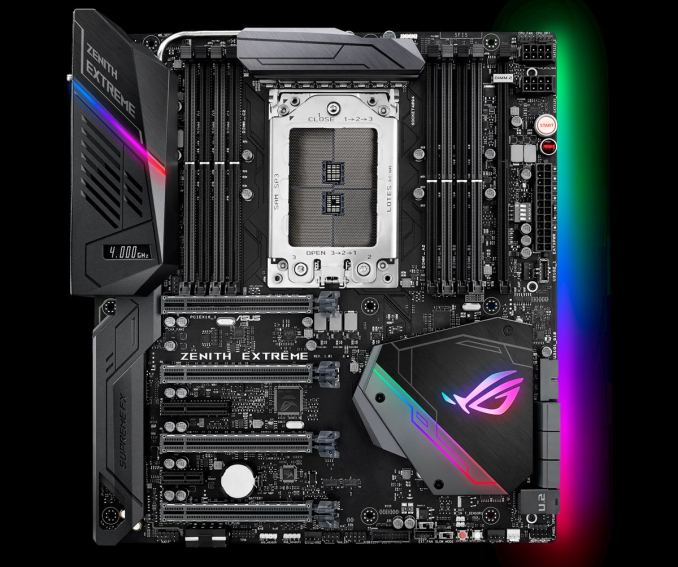




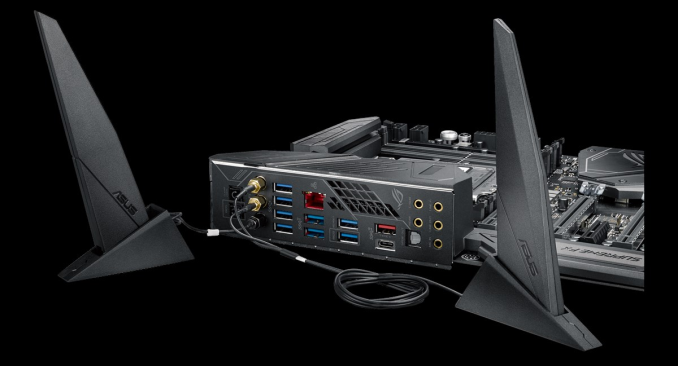
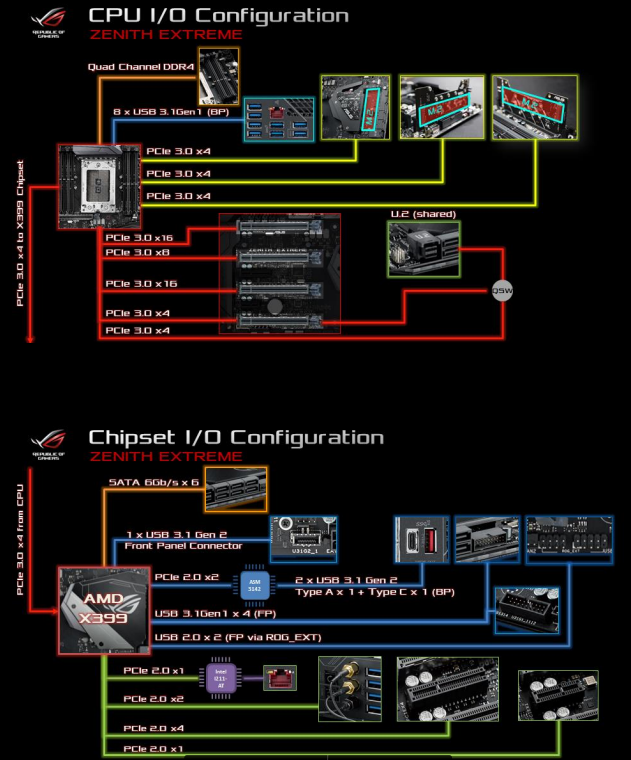








99 Comments
View All Comments
ddriver - Monday, September 18, 2017 - link
You should look up into it. A gas turbine is not a jet engine. It is actually more efficient, and it doesn't utilize jet propulsion. Gas turbines power certain tanks, ships and helicopters. They are also used in power plants.thomasg - Sunday, September 17, 2017 - link
Honestly, could you just stop bringing your stupid gas turbine rant, since you don't really seem to grasp what efficiency is, and not even what power a typical engine has.Gas turbines are very efficient in use at or around their designed typical load. They are not efficient under medium and low load scenarios, where they will drop below modern gasoline combustion engines.
Those come with 200 kW - in high-powered sports cars, or top-of-the-line luxury limousines.
A "entry level car" will be at max. 75 kW peak power; and guess what: most of the time they are used far below the maximum output.
Modern gasoline car engines typically reach 45% efficiency, which they achieve in their typical load scenarios, at less than 50% of their design load.
Modern gas turbines can reach up to 60% efficiency, which is great - but this is usage at their design load. At half load, the efficiency will drop below 30%. The majority of miles driven with cars are at below half load.
What we expect from car engines is efficiency at their usage, while having enough reserves for quick acceleration. Gas turbines cannot do this efficiently, and gas turbines are notoriously laggy in variable load.
However, they can be used effectively in fully-hybrid cars, where peak-load is achieved by battery-backed electric motors.
But since these engines are so expensive to produce, it is simply more cost-effective to use fully-electric cars for this.
ddriver - Monday, September 18, 2017 - link
Of course that a gas turbine consumer vehicle will also utilize a battery buffer. You basically charge it while stationary, drive on battery until power runs out, which is when the turbine is activated to supply power and charge. An all-electric drive will significantly simplify the design, the transmission, and will ensure maximum torque on any level of power.You are way off, only F1 engines approach 50% of efficiency, but they only last like a few races, which is the cost of that efficiency. Totally impractical for consumer vehicles. The typical operational efficiency of consumer vehicles is as low as 20%. And they are also intrinsically limited in terms of torque delivery, which happens in a specific and rather narrow RPM range.
So, transitioning to gas turbine engines will not have a 100% but a 200% increase in efficiency. I guess little minds simply cannot appreciate then significance of that. Not to mention it will defacto force wide hybrid vehicle adoption, and a very overhead compared to internal combustion engines, as a gas turbine with the same power delivery will weight 1/4 of that, and will deliver 3 times as much energy from the same amount of fuel.
Gas turbine engines are also actually easier to make and maintain, they have far less moving parts. You seem to be confusing a regular gas turbine engine with the ultra-efficient one, which requires expenssive and time staking 5 axis machining of the components. Those exceed 70% efficiency, but if you aim for 60%, the manufacturing is much cheaper, easier and faster. Overall much more cost efficient.
Which is exactly why they are not being adopted. It will result in massive loss of revenue - cheaper engines, that need less of the expensive maintenance, less parts, and burn much less fuel. The priority of the industry is profit, and gas turbine vehicles will result in a massive dip in that aspect. Internal combustion engines are pathetic in terms of efficiency, but are very profit-effective.
ddriver - Monday, September 18, 2017 - link
"and a very LOW overhead compared to internal combustion engines"vgray35@hotmail.com - Sunday, September 17, 2017 - link
Get a glue ddriver. This is not about power saved whose numbers are minuscule compared to the power o/p of an automobile engine - IT IS ALL ABOUT TEMPERATURE OF THE INTEGRATED CHIPS WHICH ARE LIMITED TO NOT MUCH MORE THAN 100 deg C, and the difficulty of providing sufficient air flow or liquid cooling necessary to remove that heat. Failure to remove the heat dramatically reduces life of the chips by as much as 60% - 70% life reduction. The problem is greatly curtailed by not using circuity designs that would generate ever larger amounts of waste heat. Please stick to subject matter of this posting, which is about reducing CPU and GPU and VRM operating temperatures, without using huge heat sinks and liquid cooling radiators. How does one reduce these temperatures? The first step is to eliminate >85% of the heat in the ATX PSU, motherboard VRMs, and GPU VRMs, to reduce total heat load on the cooling system. And that technology is already available as mentioned above. Please cease with the 100 kW rhetoric which is meaningless in context of this temperature problem (yes little k for kilo not capitol K). Let's talk about the excess temperature issue. Get it!Thread Ripper is a HEDT platform and thus deserves a HEDT VRM solution, and not the same old worn out technologies that use air-gapped ferrite cored inductors, when resonance scaling permits increased resonant capacitance in exchange for much smaller resonant inductance using cheaper air-cored inductors. And to boot, a dramatic reduction is both size and cost. AMD should lead this charge and bring forth an appropriate reference VRM, using PWM-resonant switching and resonance scaling of the Cr/Lr resonant components. ARE YOU LISTENING AMD - LETS RETIRE THE BUCK CONVERTER ACROSS THE BOARD.
ddriver - Monday, September 18, 2017 - link
Getting glue. Now what?Here is a clue - remove the stock heatsink, install better cooling. Takes like 5 minutes. Heat problem solved. Crude, but it delivers result.
The industry standards are so low, there is barely a product, regardless of its price range, that someone with basic engineering cannot tangibly improve in a few easy steps.
An example, I recently got a yoga 720 2in1. Opened it up, removed the cooling, put good TIM, reinstalled cooling, now I have a 5 minute 5$ improvement that gave me a 10% boost in performance, temperature and battery life. They are just lazy, and don't go even for the most obvious, easiest to implement improvements.
They DONT WANT IT TO RUN COOL. They deliberately engineer it to run at its limit, so close that often they actually mess it up. So that this device can fail, so you can get a new one. It is a time bomb, planned obsolescence, and you can bet your ass they would have done the same regardless of the power delivery circuit involved. It may actually be a far more delicate and harder to address time bomb than hot running VRMs. Which you can easily cool down by ordering a custom heatpipe solution, which will set you back like 50$. That's a rather quick and affordable way to solve your problem, compared to complaining about it in this cesspool of mediocrity ;)
vgray35@hotmail.com - Monday, September 18, 2017 - link
Sorry ddriver, but I disagree with all your perspectives on this matter. You are clearly not capable of addressing the technical issues of Power Supply design for efficiency, and cannot get to grips with electronic circuity (or do not want to) and how different designs compare. You appear only interested in hijacking the original subject matter for your own purposes. You never contributed a single element addressing the original purpose of this thread, and so you have lost your credibility as a serious participant in my book, and hence you and I done.glennst43 - Friday, September 15, 2017 - link
Based on my experience with the Asus Zenith Extreme, you can expect a bumpy ride which should not be surprising with a new product. My last 3 systems were Intel X58, X79, and X99 boards purchased shortly after thier releases, and this platform (x399) has had the most issues. I expect that in a few months after some BIOS and driver updates, the experiecne will get much better. I suspect that the validation process is not as thorough as the Intel boards.Here are a few issues that I have experienced as an early adopter:
System would not boot with 2 video cards (resolved with BIOS update)
The 10G Network card would randomly disconnect (resolved? with driver update)
System sometimes will not come back from sleep and requires a hard reset (no resolution yet)
USB devices disconnecting/reconnecting randomly (no resolution yet)
johnnycanadian - Friday, September 15, 2017 - link
I'm crossing my fingers I made the correct choice with MSI's x399 offering. I too have been burned by the ASUS early-adopter-penalty and although Gigabyte has been good to me in the past, the MSI offered everything I needed and then some (although I'm firmly in the "get rid of the tacky LED" camp). Everything is getting stuffed into a Cooler Master HAF XB II EVO (with no glass but with the mesh top panel). Even if it's not perfect it can't be worse than running Windows on Boot Camp with a "trash can" (aptly named) Mac "Pro".arter97 - Friday, September 15, 2017 - link
ASUS PRIME X399-A : "In the ROG board this lead to a 40mm fan, which is not present here on the Prime."This is wrong. I own one and the fan is present under the shroud.
You can even see it from the side shot of the motherboard.